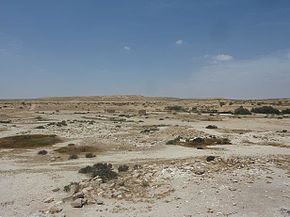Haluza
| חלוצה | |

Overview of Haluza
|
|
| Alternate name | Halasa Chellous al-Khalasa Elusa |
|---|---|
| Location | Southern District, Israel |
| Region | Negev |
| Coordinates | 31°05′49″N 34°39′07″E / 31.097°N 34.652°ECoordinates: 31°05′49″N 34°39′07″E / 31.097°N 34.652°E |
| Type | Settlement |
| History | |
| Cultures | Nabataean, Roman |
| Site notes | |
| Condition | In ruins |
| Official name | Incense Route - Desert Cities in the Negev (Haluza, Mamshit, Avdat and Shivta) |
| Type | Cultural |
| Criteria | iii, v |
| Designated | 2005 (29th session) |
| Reference no. | 1107 |
| State Party | Israel |
| Region | Europe and North America |
Haluza (Hebrew: חלוצה), also known as Halasa, Chellous (Χελλοὺς in Greek, although in the 6th-century Madaba Map the town appears as ΕΛΟΥCΑ), Elusa, al-Khalasa and al-Khalūṣ (Arabic), is a city in the Negev, Israel, that was once part of the Nabataean Incense Route. Due to its historic importance, UNESCO declared Haluza a World Heritage Site along with Mamshit, Avdat and Shivta. The city is one of the two main potential locations for the Biblical city of Ziklag,Ziklag being considered in this case a corruption of Halusah, meaning fortress. In Saadia Gaon's Judeo-Arabic translation of the Pentateuch, the biblical town of Gerar is associated with Haluza (Judeo-Arabic: אלכ'לוץ = al-Khalūṣ).
The city is mentioned under the name 'Chellous' (Χελλοὺς) in the Greek text of Judith, i, 9. It is also mentioned by Ptolemy as being in Idumaea, Peutinger's Table, Stephanus Byzantius (as being formerly in the province of Arabia Petraea, now in Palaestina Tertia), Jerome, the pilgrim Theodosius, Antoninus of Piacenza, and Joannes Moschus.
...
Wikipedia

